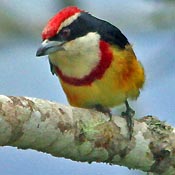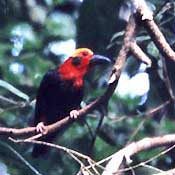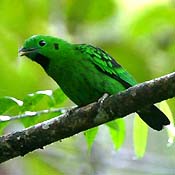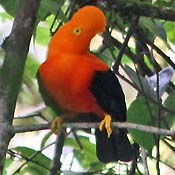| |
|
# |
Species [range] |
Photo/art [see credits];
all photos taken in the wild |
Summary of reasons for this choice |
DR seen? |
31 |
Scarlet-banded Barbet
Capito wallacei
[n. Peru] |
|
The Andes of South America are known for the diversity of birds and the prevalence of endemism, and nothing better illustrates this than the spectacular new barbet discovered in cloud forest on an unnamed peak near the upper Rio Cushabatay in Peru's eastern Andes. Discovered by LSU researchers (see also Orange-throated Tanager, below) in 1996 and named in 2000 (Auk 117: 569-577), it is as gorgeous as a barbet can get. In recent years it has been discovered at other sites nearby, and can be seen after an arduous jeep trip. |
Yes |
32 |
Bornean Bristlehead
Pityriasis gymnocephala
[Borneo] |
|
Bornean Bristlehead is a very odd, striking, elusive, and mysterious bird. It has only recently been recognized as the monotypic member of its own family, with no very close relatives on earth. Restricted entirely to remnants of lowland rainforest on Borneo, it is generally difficult to locate and observe, and is now perhaps "the" primary target on a bird trip that magic island; more on my Bristlehead family page. |
Yes |
33 |
Whitehead's Broadbill
Calyptomena whiteheadi
[Borneo] |
|
Of two dozen endemics in the Bornean highlands, none are more sought after than the "Whitehead's trinity:" a trogon, spiderhunter, and broadbill. The latter is among the most impressive birds I've seen: a glowing velvet-green cock-of-the-rock! The red or orange cock-of-the-rocks make this listing (just above) and this bird is right there with them. Its array of vocalizations almost equals its plumage. Although it is easy enough to reach Mt. Kinabalu, the world's largest broadbill remains elusive in the thick mossy forest. |
Yes |
34 |
Helmeted Hornbill
Buceros vigil
[Malay Peninsula & Greater Sundas] |
|
Among huge birds of Old World tropics, the most impressive may be hornbills. The largest are in genus Buceros in the Oriental lowlands. Each is wonderful: Rhinoceros B. rhinoceros has a spectacular bill, Great B. bicornis is a giant from India to Malay Pen.; Rufous B. hydrocorax is a Philippine endemic; and Helmeted B. vigil, now hunted for its casque and recently listed as Critically Endangered. I opt for Helmeted of the Malay Pen., Sumatra & Borneo because of its scarcity and its unworldly calls. These may be the most awe-inspiring vocalizations in the avian realm. |
Yes |
35 |
Andean Cock-of-the-Rock
Rupicola peruviana
[western South America]
|
|
The two Cocks-of-the-Rock are among the most memorable birds in South America. The Andean Cock-of-the-Rock, with glowing red-and-black males, lives in wet subtropical forest from Colombia & w. Venezuela to Bolivia. Andean Cock-of-the-Rock was the bird we most sought after during my first trip to South America, and it was shy and elusive then. There are now many more sites to find them, but one never tires of seeing the spectacular males. The chestnut-brown females are retiring but sport the unique big-headed crest proportions shared by the males. |
Yes |
| 36 |
Guinean Cock-of-the-Rock
Rupicola rupicola
[northeastern
South America] |
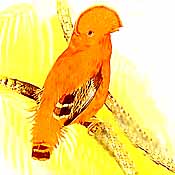 |
The two Cocks-of-the-Rock are among the most memorable and unique birds in South America. The Guinean Cock-of-the-Rock, with bright orange males, occurs in rocky subtropical forests from Venezuelan tepuis to the Guianas and n. Brazil. Males mostly display and vocalize, while females wear unobtrusive green or brown plumages, and raise the young on their own. Like the Andean, male Guinean Cock-of-the-Rocks gather at leks in the forest to display and attract females. In a global sense, the two Cock-of-the-rock species are the Neotropic version of Papuan birds-of-paradise. |
Yes |
| 37 |
Indian Bustard Ardeotis nigriceps
[India & eastern Pakistan]
|
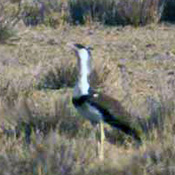 |
The Great Indian Bustard is critically endangered. It was in decline when we saw it in Desert NP, near the Pakistan border of India in 2001 It is one of three huge Ardeotis bustards; fortunately, Kori (Africa) and Australian (Australasia) Bustards have larger populations [see my out-dated "big bustards" page]. Arabian Bustard Ardeotis arabs is smaller but also declining. Great Bustard Otis tarda, ranging from Spain to China, is now patchy and rare. Any bustards is impressive, but these large, rare species need extensive grasslands or uninhabited desert. It is a thrill to see any of them. |
Yes |
38 |
'Akohekohe
Palmeria dolei
[Maui, Hawaii] |
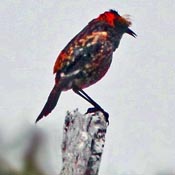 |
When this "best birds" project began [1974], 3 Hawaiian Honeycreepers made the initial "top 50": Kauai 'Akialoa Hemignathus stejnegeri, 'O'u Psittirostra psittacea, and this, then known as "Crested Honeycreeper." The 'Akialoa went extinct in 1969; 'O'u was lost about 1987. This species was gone from Molokai by 1960 but a small population (~3500) of 'Akohekohe still live in prime cloud forest on the windward side of Maui's Haleakala volcano. Maui Parrotbill (below) shares that habitat but is rarer (about 500). I waffled on which to choose, and have now included both. |
Yes |
| 39 |
Maui Parrotbill
Pseudonestor xanthophrys
[Maui, Hawaii] |
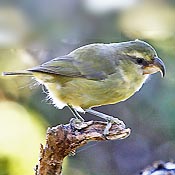 |
Maui Parrotbill shares the same habitat that still holds a population of 'Akohekohe (above) — prime cloud forest on the windward side of Maui's Haleakala volcano. It has declined seriously over the decades and today only perhaps 500 still survive. It has a totally unique bill among the Hawaiian Honeycreepers — a set that has many strange bills among them — and is absolutely thrilling to glimpse in the remaining rainforest canopy. It took me 3 trips over 26 years to finally see one. |
Yes |
| 40 |
Giant Pitta
Pitta caerulea
[southeast Asia] |
|
The world's largest pitta is scarce — when found it may be the highlight of a trip to the Greater Sundas, peninsular Malaysia, or Thailand. Ground-dwelling pittas with their haunting voices are among the globe's most fascinating birds. Many qualify for this list: Superb P. superba in the Admiralty Is., Ivory-breasted Pitta P. maxima on Halmahera, or two Philippine pittas: Azure-breasted P. steerii and Whiskered P. kochi (both original "top 50" picks decades ago). My experience with Blue-headed P. baudii of Borneo was breathtaking, but I pick this one first. |
Yes |
|
CREDITS:
All the artworks are copyrighted by the artist (as detailed below) and are either used with permission or are posted here in reliance on the non-commercial "fair use" doctrine; all rights are reserved by the artist
- Martin Woodcock painted the Black-necked Red-Cotinga, from The Cotingas (1982) by David Snow (British Museum), and the Giant Pitta, from Pittas, Broadbills and Asities (1996) by Frank Lambert & Martin Woodcock
- Rangkong Indonesia, an organization working on protection for Helmeted Hornbill, display this art of a Helmeted Hornbill in flight on their website [© Rangkong Indonesia], and used here under the fair use doctrine
All the photographs are copyrighted by the photographer (as detailed below) and are used with permission; all rights are reserved to the photographer
- Don Roberson photographed Scarlet-banded Barbet (Peru), Andean Cock-of-the-Rock (Peru), Great Indian Bustard (India), and 'Akohekohe (Maui, Hawaii).
- James Eaton photographed the Bornean Bristlehead (Sabah, Malaysia)
- Hideo Tani photographed the Whitehead's Broadbill (Mt. Kinabalu, Borneo, Sabah, Malaysia)
- Michael Walther photographed the Maui Parrotbill (Maui, Hawaii)
|
or the picks via links at right:
|
|
|
|
|


